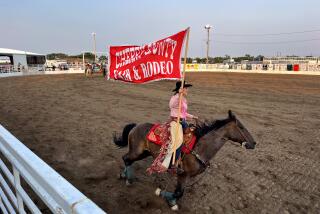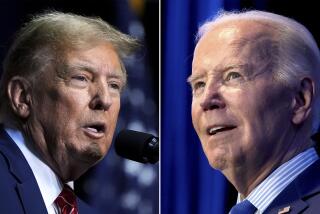South Dakota’s Primary Puts Pressure on Kerrey and Harkin : Politics: A poor showing by either farm-state candidate could doom their campaigns. New Hampshire vote has muddled the contest.
- Share via
SIOUX FALLS, S.D. — After months of scrutiny in New Hampshire culminated in a vote that failed to eliminate even one presidential candidate, the whole Democratic herd has stampeded into South Dakota for a brief but intense battle to win the nation’s second primary on Tuesday.
If anything, last Tuesday’s New Hampshire primary further scrambled the South Dakota race because the Granite State’s top vote-getters--former Massachusetts Sen. Paul E. Tsongas and Arkansas Gov. Bill Clinton--are strangers in the Midwest.
Two of their three major rivals--Nebraska Sen. Bob Kerrey and Iowa Sen. Tom Harkin--are farm-country neighbors who hope that their familiarity with the terrain will breed success.
Following their back-of-the-pack finishes in New Hampshire, the stakes for Kerrey and Harkin have become especially high. Poor showings in South Dakota could effectively end their campaigns.
The fifth nationally prominent Democratic contender, former California Gov. Edmund G. (Jerry) Brown, has focused most of his attention on today’s Maine caucuses, but he purchased time on South Dakota television stations to air a 30-minute program on his candidacy that initially was shown in New Hampshire.
Republican voters also go to the polls Tuesday in South Dakota, but their choice is predetermined. President Bush is the only name on the GOP primary ballot, and no write-ins are allowed.
Bush’s challenger, Patrick J. Buchanan, tried to get on the ballot, but state party leaders told him that his December campaign announcement came too late to qualify. Buchanan took the issue to court, but a judge rejected the claim last month.
Among the Democrats, Kerrey in particular has gone all out over the last few days. As he toured a firehouse in Sioux Falls on Saturday, he was already talking about a rejuvenating victory.
“It will be a lift for me, and it will carry me into Colorado and the South,” he said, referring to primaries within the next few weeks. “I’m just very enthusiastic about where we are.”
Kerrey’s confidence was boosted by a local newspaper poll, published Saturday, that found him leading his opponents by about 10 percentage points, with a close race for second place among Harkin, Tsongas and Clinton.
But the poll also showed that more than a quarter of the state’s electorate remains undecided.
“It’s certainly a wide open race,” said Karen Schrier, head of the South Dakota Democratic Party. “Even people who are normally political insiders who make up their minds early are changing their minds a lot and waiting until the last minute.”
The fluid situation makes a candidate debate to be held tonight in Sioux Falls and televised on local stations loom even larger because it likely will give many South Dakota Democrats their first close look at their party’s White House aspirants.
The large percentage of undecided voters and relatively cheap rates for television advertising probably helped make South Dakota attractive to Tsongas and Clinton. As little as $30,000 will buy saturation-level television time for a week. The result has been a slew of TV ads by all of the Democrats except Brown.
For Clinton and Tsongas, the South Dakota contest is generally seen as a no-lose situation, given that they are competing against regional favorites. But the result in South Dakota could add some definition to a potential showdown elsewhere if it reinforces perceived strengths or weaknesses of either candidate.
Clinton is hoping for confirmation that voters still consider him electable despite unsubstantiated allegations of marital infidelity and questions about his Vietnam War-era draft status that plagued his campaign in New Hampshire.
Tsongas is hoping that a good showing in South Dakota will help him shed the image of a candidate who cannot attract votes outside New England.
So far, it has not been easy for Tsongas to blend into farm country.
He has sought to forge a link with the state by running a TV ad featuring his father-in-law, a former football star at the University of South Dakota. But last Thursday, when Tsongas brought two busloads of reporters to a stockyard in Sioux Falls, he had to admit that he is not very knowledgeable about agriculture.
“I’m trying to learn,” he said.
Calling attention to Tsongas’ lack of background on farm issues is his booklet “A Call to Economic Arms,” which served as the cornerstone of his successful campaign in recession-racked New Hampshire but does not contain a word about agriculture, an omission Kerrey has noted in one of his television ads.
South Dakota at a Glance
* Total population: 696,004
Females: 353,506
Males: 342,498
* Unemployment rate: 3.1% (December, 1991)
* Median rent (1990): $242
* Total registered voters
Republicans: 207,036
Democrats: 180,181
Other: 33,134
Total: 420,351
* 1988 presidential primary winners
Michael S. Dukakis (as a write-in)
George Bush
* 1988 presidential vote
Dukakis: 46.5%
Bush: 52.8%
* 1992 delegates at stake
Democrats: 15
Republicans: 19
* Race
White: 91.6%
American Indian: 7.3%
Black: 0.5%
Asian: 0.4%
Latino: 0.8%
Other: 0.02%
* Violent Crime
162.8 per 100,000 population in 1990
Sources: U.S. Census Bureau, FBI’s Uniform Crime Report
More to Read
Get the L.A. Times Politics newsletter
Deeply reported insights into legislation, politics and policy from Sacramento, Washington and beyond. In your inbox twice per week.
You may occasionally receive promotional content from the Los Angeles Times.










